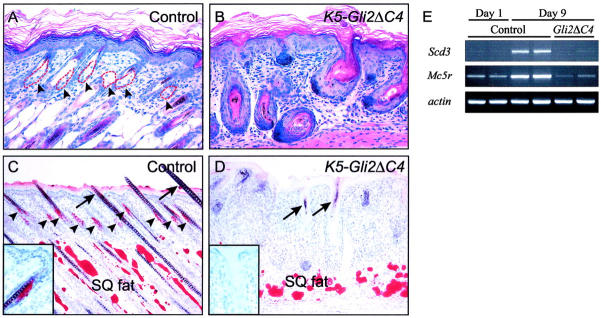Figure 1.
Dominant-negative inhibition of Gli activity blocks sebocyte development. A and B: H&E staining of skin from 7-day-old control and K5-Gli2ΔC4 transgenic mice. Clusters of sebocytes are seen associated within the superficial portion of control hair follicles (dashed red lines and arrowheads in A, but not in aberrant hair follicles arising in transgenic skin in B). C and D: Oil Red O staining for lipids. Note the presence of large, amorphous masses of adipocytes staining in subcutaneous fat layer (SQ fat) in both the control (C) and transgenic (D) skin sections. Staining of sebaceous glands is limited to control skin (inset and arrowheads in C). Despite the reduced length of follicles in K5-Gli2ΔC4 mice (compare B and D with A and C), the transgenic hair follicles express multiple markers for hair follicle lineages (in preparation) and assemble abortive, pigmented hair shafts (arrows in D). E: Semiquantitative RT-PCR for sebocyte markers reveals up-regulation of Scd3 and Mc5r in control skin between postnatal day 1 and day 9, reflecting expansion of the sebocyte lineage during this time. Expression of transcripts encoding sebocyte markers in skin from day 9 K5-Gli2ΔC4 samples (Gli2ΔC4) was similar to that of day 1 control samples.

